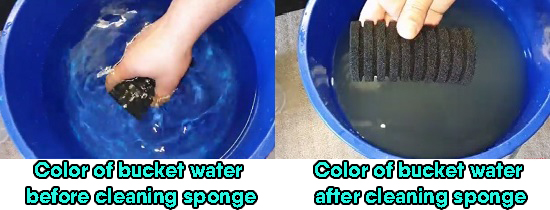[ad_1]
Every aquarium needs a quality filter for removal of fish poop, remaining food, & other decaying matter from the aquarium water. Filters can perform mechanical, chemical & biological filtration. Chemical filtration is not necessary but will be very helpful in case of emergency. But mechanical & biological filtration are very important for cleaning your aquarium water. Mechanical filtration media traps solid waste particles while water containing toxic chemicals released from fish waste can pass through the mechanical filtration media but bio media is responsible for cleaning these chemicals. Lack of biological filtration can be fatal & in fact biological filtration is the most important of all types of filtration.
How to clean aquarium internal filter containing one sponge:

Fill bucket with aquarium water
If you have one sponge in your filter then clean it after every 2 weeks. Fill a clean bucket with aquarium water & gently squeeze the sponge in the bucket water till it stops releasing yucky water. Cleaning usually takes from 30 to 45 seconds but it depends on how dirty your sponge is. If you are keeping many fish in your aquarium then your sponge would have trapped lots of fish waste & it will take more time in cleaning. If your sponge is very dirty then use another bucket of water too. First clean your internal filter sponge in the first bucket till the bucket water gets dirty. Then clean your filter sponge in the second bucket till it stops releasing murky water. When your sponge is clean then quickly install it back in your internal filter & install your filter back in your aquarium. Make sure you press the suction cups (located at the back of the filter) tightly against the tank glass & turn on the filter immediately. If you leave the sponge outside water & it dries then dryness will wipe out good bacteria in the sponge because useful bacteria can only survive inside water.

Proper way of cleaning internal filter media
The best time for internal filter maintenance is during or after water change.
Keep separate stuff for fish tanks & avoid using them for other purposes as they may consist of toxic chemicals that can harm your aquarium inhabitants.
How to clean internal filter containing multiple sponges:
If you have multiple sponges in your internal filter then clean only one sponge at a time because sponge allows heaps of good bacteria to grow on its surface. Cleaning a sponge means that you will lose most or all of the good bacteria that the sponge has accumulated. Wait for about 2 weeks then clean another sponge, & repeat the process.
Sponges can offer both mechanical & biological filtration. Even without bio media, sponges are very efficient in biological filtration because they offer a large surface for the growth of good bacteria. Sponges only hold the nitrifying bacteria that breaks down ammonia into nitrites & further into nitrates. Nitrifying bacteria consumes both ammonia & nitrites that are highly toxic but leave lesser toxic nitrates. Sponges can’t hold denitrifying bacteria that grow in oxygen free places. Denitrifying bacteria wipes out nitrates from the aquarium water. Some bio media like ceramic noodles hold denitrifying bacteria for removing nitrates from the aquarium water. If your sponge filter only contains sponges then they hold nitrifying bacteria so the filter will release water containing nitrates. For removal of nitrates from the aquarium water either change partial water on a weekly basis or add aquatic plants that consume nitrates.
Why aquarium internal filters are very effective in both mechanical & biological filtration:
Sponge provides lots of surface area which allows heaps of beneficial bacteria to cling to it. Sponge filters are best for biological filtration even though they don’t have bio media. Some internal filters have separate compartments for bio media but if your filter only has one or multiple sponges then don’t worry because it will perform double duty such as it will trap fish waste & other debris (mechanical filtration), & break down ammonia released from fish waste & other decaying matter into nitrites & further converts it into nitrates (biological filtration).
Conclusion:
Sponge filters are great because they can do both mechanical & biological filtration very efficiently. Internal filters usually use one or multiple sponges that offer a large surface for colonizing heaps of good bacteria.
[ad_2]
Source by [author_name]



